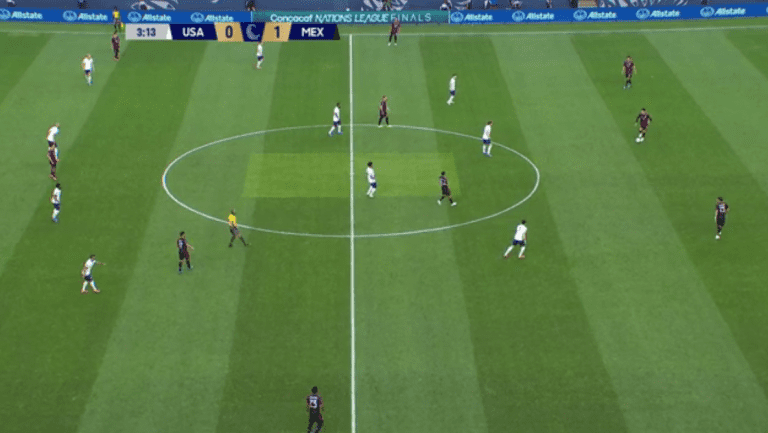I’m going to borrow my own line from last weekend following the USMNT's friendly loss to Switzerland: Friendlies are friendlies, and good teams know how to work their way through them and find good stuff to learn and take away from them, then apply them for real when the whistle blows in official competitions.
But history is littered with teams who did only part of that and were just never able to flip that switch, get out of third gear and get into "must-win" mode.
This is especially true of young teams. Veteran sides have, by definition, been there before and more often than not know where to find the switch and how to turn it on. Young teams? Well, it’s a journey.
This is a point I’ve made repeatedly over the past few years, but especially in the past week. I was not sure if this team even knew how to begin looking for the switch, and was worried they'd become somewhat complacent.
That worry was unfounded. The biggest takeaway I will have from the initial Concacaf Nations League is that this almost impossibly young US men’s national team collectively found that switch and, after a good deal of effort, figured out how to turn it on. They navigated the distance between “friendly” and “this game has stakes."
We saw the beginnings of it in the 1-0 win over Honduras. They at least located the switch, and a few of the players on the team — most notably John Brooks — flipped it on.
“We needed this kind of game,” said US head coach Gregg Berhalter afterwards, and he has never been more correct. Without suffering through the win over the Catrachos there is no momentous, wild-as-all-hell 3-2 win over Mexico Sunday night, a game in which, after 25 minutes, the US finally, collectively found the switch and met the urgency of both the moment and their opponents.
So before you read anything that I or anyone else writes about tactics, remember the very simple foundation of what we just saw from the US is that good things happen when you play really hard, and play with confidence. If you don’t do that, you can suffer the most ignominious of defeats (cough *Couva* cough cough) no matter how weak the competition.
If you do the above and have lots of talent? If that's the case, then great things are possible. And coming from behind twice against a veteran Mexican side that has dominated this rivalry for a decade qualifies as great.
The players knew it. You could see it in how they carried themselves even after being rocked back by an early uppercut. You could see it in their goal celebrations, and you could see it in the way they matched or exceeded Mexico’s energy not just on the field, but in the extracurriculars that are very much part of this rivalry.
I’m not going to go so far as to say nothing matters beyond achieving that level of urgency. But I will say if the US hit, as a baseline, the level of urgency we saw from minute 25 onwards Sunday night, then this group will qualify for the World Cup with ease no matter what the tactics are.
That said, the tactics did indeed help! Let’s take a quick look:
There was talk of a massive formation switch from the US in the hours before the game, and when the lineups came out that seemed to be confirmed: The US would play in a 3-4-2-1. And they did, except for a lot of times when they didn’t.
The US played what Berhalter called “an adaptive shape,” one that often looked as much like an unbalanced 4-4-2 with the right back (DeAndre Yedlin) and right midfielder (Gio Reyna) pushing higher and tucking in a bit compared to the left side, where Tim Ream as a stay-at-home left back and Sergino Dest was an old-fashioned wide left midfielder.
You could see it early both in simple possession (of which there wasn’t much), as well as in regular defensive sequences:

Berhalter explained it afterwards in fine detail.
“We started with a five in the back. But if you think about this shape, it was an adaptive shape. So any time they went to build with two, we would move to press with two; any time they built with three, we would move to press with three,” Berhalter said. “And then our wingbacks fluctuated between Sergino being a left midfielder and being a left wing back … and then Gio being a high winger or a right midfielder, basically.”
This is weird! We’ve seen a lot of different looks from the US before under Berhalter, but not this one. It’s a huge gamble to go with something so different in a game of this magnitude.
But I would say it worked. The front line did a good job of closing Mexico down out of the mid-block and the backline won a ton of the long-balls El Tri were forced into. The US got forward a good amount in transition, and since they were essentially playing with two up top, they almost always had numbers to put the Mexican backline under pressure and force them to scramble.
One of the things Berhalter has talked about a ton in his two-and-a-half years in charge is the concept of disorganizing the opponents without the ball. The US are going to face a lot of bunkers in Concacaf; they always have. And they’ve often struggled against those bunkers, while Mexico — who have long been more comfortable breaking teams down with the ball — have a habit of taking the smaller Concacaf sides apart.
So the coach has seen it as his mandate, from Day 1, to get the US to play better in those situations, and at times (including and especially in the most recent meeting with Mexico, a 3-0 friendly loss in which the US repeatedly tried to play through the Mexican press and couldn’t) it felt like they were doing it to their detriment. There has been a sense in certain corners of USMNT fandom that when the time came, Berhalter would instruct the team to go out on their shield instead of being a little bit more pragmatic.
Those fears turned out to be unfounded. Playing more of a mid-block and using a double pivot of Weston McKennie and Kellyn Acosta gummed up central midfield — Mexico created almost nothing up the gut — and turned it into a game of second balls and transition moments
The US got into a lot of good spots in those transition moments. As was the case vs. Honduras, they simply were not sharp in the final third:
El Tri, meanwhile, were forced to just repeatedly play into the channels.
There are always trade-offs in any gameplan. The US were never going to completely dominate this game, and I think Berhalter got the trade-offs correct here. Yes, Mexico were dangerous playing into those channels, but pushing Yedlin up high dulled a lot of Jesus “Tecatito” Corona’s influence in the build-up, while Brooks was almost flawless in his reads and rotations to contain Hirving “Chucky” Lozano playing as a false 9.
So the gamble was to try to limit those guys and force Uriel Antuna to make plays, or force Carlos Rodriguez to win the game bursting out of central midfield.
They could not. Berhalter gambled well.
When Tim Weah came on for Dest at the hour mark I’d argue the “adaptive back five that can, and did often, look like a back four” ended up becoming an adaptive back four that can and sometimes did look like a back five. That is the nature of the game, though: formations are supposed to be liquid.
The hard-and-fast change, though, came late when Tyler Adams came on, Tim Ream came off and Acosta went to left back. That became a real 4-3-3 with Adams destroying everything through central midfield and Acosta tasked with shutting down Diego Lainez, who’d created more danger in two touches than Antuna could’ve in two hours.
The adjustment obviously came a bit too late. Lainez got on the field in the 78th minute and scored in the 79th, while Adams didn’t get onto the field until three minutes after that. But it was the right adjustment, and I would argue it gave the US a little more control over the game down the stretch and then throughout all of the extra time festivities.
If you go back and watch those final 40 minutes (50 minutes when stoppage time is factored in) you’ll see that Mexico were limited to long-range blasts or set pieces, while the US ended up becoming more and more dangerous via possession. They didn’t turn the game on its head, precisely, but they did change the way it was played — and eventually they reaped the rewards of that.
A few bullet-points:
- McKennie was a one-man wrecking crew on set pieces. Tata Martino is taking a beating for a lot of things in the Mexican press this morning, but the one they should really be going after him for is the inability to contain the US on restarts when the US lineup really only had two good targets in McKennie and Brooks.
- When the ball was live, Christian Pulisic was poor right up until he made what turned out to be the match-winning play. I kind of wonder if, now that he has this wonderful moment vs. Mexico under his belt, he’ll stop trying to recreate Maradona’s World Cup goal on every touch and become more willing to play within the framework of the game.
- Dest looked completely out of gas and I think part of Berhalter’s “adaptive shape” was a concession that Sergino is not ready to play as a true fullback in a back four against a team as good as Mexico.
- As demonstrated by the performances of Ream and Mark McKenzie, the race to be Brooks’ partner in central defense is wide open. I hope we’ll see a lot of Miles Robinson and Walker Zimmerman at the Gold Cup, and Chris Richards as well.
- I don’t think anyone helped himself more with regard to where he stands in the pool than Acosta, who put in a more-than-credible shift at two spots.
The US play Costa Rica on Wednesday (7 pm ET | ESPN2, UniMás, TUDN) in a friendly, a game added to the schedule in order to replicate the conditions of the three-game windows that are going to be a feature of the upcoming run through World Cup qualifying.
Somehow harnessing the fortitude to recover from such an emotional win and summon the energy necessary to beat the Ticos, even in a friendly... well, Berhalter scheduled this game for a reason. It's another big test, and another switch this young US team needs to flip. It'll be fascinating to see if they can manage it once again.












